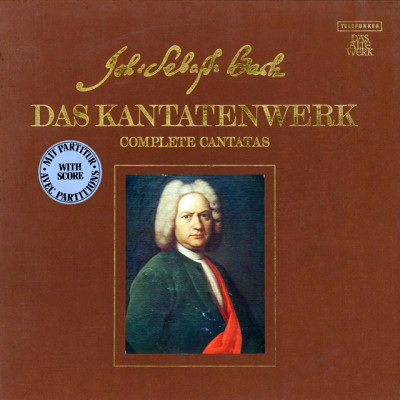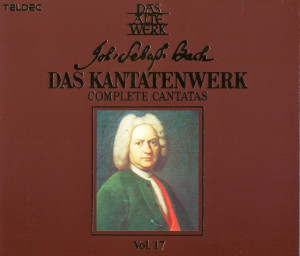 |
|
2 LPs
- SKW 17/1-2 - (p) 1977
|
 |
| 2 CDs -
8.35335 ZL - (c) 1988 |
|
| DAS KANTATENWERK - Volume 17 |
|
|
|
|
|
|
|
| Johann Sebastian
BACH (1685-1750) |
Kantate
"Erfreute euch, ihr Herzen", BWV 66
(Dialogus)
|
|
30' 55" |
|
|
Kantate
am 2. Osterfesttag (Feria 2 Paschatos)
|
|
|
|
|
Text:
Textdichter unbekannt; Leipziger
Kirchenmusik 1731; 6. Osterlied um 1200
|
|
|
|
|
Solo:
Alt (Furcht), Tenor (Hoffnung), Baß -
Chor; Tromba da caccia; Oboe I, II;
Fagotto; Streicher; B.c. (Violoncello,
Violone, Organo)
|
|
|
|
|
- 1.
Coro: "Erfreut euch, ihr Herzen"
|
10' 28" |
|
C1 |
|
- 2.
Recitativo (Basso): "Es bricht das Grab
und damit unsre Not" |
0' 31" |
|
C2 |
|
- 3.
Aria (Basso): "Lasset dem Höchsten ein
Danklied erschallen" |
6' 34" |
|
C3 |
|
- 4.
Recitativo-Arioso-Recitativo (Alto,
Tenore): "Bei Jesu Leben Freudig sein" |
4' 44" |
|
C4 |
|
- 5.
Aria (Duetto) (Alto, Tenore): "Ich fürchte
zwar (nicht) des Grabes Finsternissen" |
8' 13" |
|
D1 |
|
- 6.
Choral: "Alleluja! Alleluja! Alleluja!" |
0' 25" |
|
D2 |
|
|
|
|
|
|
Kantate
"Halt im Gedächtnis Jesum Christ",
BWV 67 |
|
13' 30" |
|
|
Kantate
am Sonntag Quasimodogeniti (Dominica
Quasimodogeniti) |
|
|
|
|
Text:
Textdichter unbekannt; 1. 2. Timotheus 2,
8; 4. Nikolaus Herman 1560; 7. Jakob Ebert
1601 |
|
|
|
|
Solo:
Alt, Tenor, Baß - Chor; Corno da caccia;
Flauto traverso; Oboe d'amore I, II;
Violino I, II, Viola; B.c. (Violoncello,
Violone, Organo) |
|
|
|
|
- 1.
Coro: "Halt im Gedächtnis Jesum Christ" |
3' 06" |
|
D3 |
|
- 2.
Aria (Tenore): "Mein Jesus ist erstanden" |
2' 37" |
|
D4 |
|
- 3.
Recitativo (Alto): "Mein Jesu, heißest du
des Todes Gift" |
0' 25" |
|
D5 |
|
- 4.
Choral: "Erschieden ist der herrlich Tag" |
0' 23" |
|
D6 |
|
- 5.
Recitativo (Alto): "Doch scheinet fast,
daß mich der Feinde Rest" |
0' 49" |
|
D7 |
|
- 6.
Aria (Basso): "Friede sei mit euch" |
5' 14" |
|
D8 |
|
- 7.
Choral: "Du Friedefürst, Herr Jesu Christ"
|
0' 42" |
|
D9 |
|
|
|
|
|
Paul
Esswood, Alt
Kurt Equiluz, Tenor
Max van Egmond, Baß
Knabenchor Hannover |
Heinz Hennig, Leitung
Collegium Vocale Gent | Philippe
Herreweghe, Leitung
Das verstärkte LEONHARDT-CONSORT mit
Originalinstrumenten
- Don Smithers, Naturtrompete in D
- Don Smithers, Corno da tirarsi
- Barthold Kuijken, Querflöte
- Ku Ebbinge, Bruce Haynes, Oboen
- Ku Ebbinge, Bruce Haynes, Oboen
d'amore
- Marie Leonhardt, Lucy van Dael, Alda
Stuurop, Antoinette van den Hombergh,
Janneke van der Meerm, Violinen
- Wiel Peeters, Ruth Hesseling (BWV 66;
67,2), Wim ten Have (BWV 67), Violen
- Brian Pollard, Fagott
- Anner Bylsma, Dijck Koster (BWV 66,1/6;
67), Richte van der Meer (BWV 66,2,3; 67,2),
Violoncelli
- Anthony Woodrow, Violone
- Gustav Leonhardt, Bob van Asperen (BWV
66,2,3; 67,2), Orgel
Gustav Leonhardt, Gesamtleitung
|
|
|
|
|
Luogo
e data di registrazione |
|
Amsterdam (Holland) -
Giugno 1976
|
|
|
Registrazione: live
/ studio |
|
studio |
|
|
Producer |
|
Wolf Erichson
|
|
|
Prima Edizione LP |
|
Telefunken "Das Alte
Werk" | SKW 17/1-2 | 2 LPs -
durata 33' 20" - 44' 25" | (p)
1977 | ANA
|
|
|
Edizione CD |
|
Teldec Classics |
LC 6706 | 8.35335 ZL | 2 CDs -
durata 33' 20" - 44' 25" | (c)
1988 | ADD |
|
|
Cover
|
|
Johann Sebastian
Nach, einige Jahre vor seiner
Ernennung zum Kantor in Leipzig.
Gemälde con JJ. Ihle (1720) Bach
Museum Eisenach.
|
|
|
Note |
|
In questo volume sono
presenti anche La Cantate BWV 65 e
BWV 68 a cura del Concentus
Musicus Wien diretto da Nikolaus
Harnoncourt.
|
|
|
|
|
INTRODUCTION
by Ludwig Finscher
“Erfreut euch, ihr
Herzen” (BWV 66)
probably also belongs to
Bach’s first Leipzig annual
cantata set, and was thus
prepared for Easter Monday,
1724. Admittedly it was not
newly composed; for in its
essentials the music goes
back to a Köthen birthday
cantata, the text of which
has been retained. The
unknown Leipzig author in
1724 had the thankless task
of inventing an Easter
Monday text to Bach’s music.
Undoubtedly it is due to the
difficulties of this task
that the text does not deal
more precisely with the
epistle or the gospel of the
day, but rather tends to
circumscribe the general
Eastertide jubilation. In
the detailed work, however,
it makes clever use of some
possibilities of emotional
description and word
painting. The whole work is
attuned to festive
exultation and powerful
contrasts, as was
appropriate to a
congratulatory cantata. The
broadranging introductory
chorus is conspicuously
similar to that of the
Christmas Oratorio: very
expansive da capo settings,
instrumental and vocal
brilliance in the main
section, tonal reduction and
at this point
extraordinarily bold
chromatics in the middle
section. The duet passages
of the last mentioned were
probably sung in solo form
in the secular original,
i.e. by the allegorical
persons “Glückseligkeit
Anhalts” and “Fama”. A brief
accompagnato leads on to the
bass aria, which in time,
key and cadence is related
to the chorus. Then “Furcht”
(fear) and “Hoffnung” (hope)
speak their piece, initially
in a grand, rhetorically
very carefully worked out
recitative-arioso
duet-recitative block, and
then in an elegant,
wide-ranging homophonic duet
with concertante violin. The
conclusion is formed by a
simple cantionale style
chorale.
“Halt im Gedächtnis Jesum
Christ” (BWV 67) was
composed for the first
Sunday after Easter, thus
following BWV 66 after an
interval of one week; as
opposed to the latter,
however, it is an original
composition. The text, once
more anonymous, develops
with drastic vividness from
the gospel (the story of
doubting Thomas) the
contrast between the
Christians who are
continually under attack and
the redeemer in his
unceasing struggle on their
behalf. This culminates in
the absolutely dramatic
“appearance” of Christ
(“Friede sei mit euch” =
peace be with ye) and the
congregation’s concluding
acknowledgement of Christ as
the provider and guardian of
external and internal peace.
Bach did not close his eyes
to the suggestiveness of
this unusually clever text.
The cantata is one of the
most magnificent works of
the first Leipzig annual
set, and from a formal and
technical point of view one
of the most original Bach
cantatas altogether. The
introductory chorus spreads
the text over two themes
which are simultaneously
emotional and descriptive;
from the chorale-like,
stylised injunction “Halt im
Gedächtnis Jesum Christ” the
word “Halt” ist also split
off as the emphatic cry of
the chorus. In form the
movement is an ingenious,
complicated entity in which
symmetry and intensifying
passages intermingle with
each other: Sinfonia -
chorus with independent
instrumental movement -
choral fugue - sinfonia with
chorus - chorus with
independent instrumental
movement - choral fugue with
instruments - sinfonia with
chorus. Tenor and contralto
take over the following solo
numbers. The tenor aria in
which the attacks begin is
answered by the contralto
recitative with
encouragement, which is
reinforced by the inserted
chorale; the immediately
following second contralto
recitative again conjures up
the picture of the
oppressing enemies. In the
succeeding choral aria,
which is almost unique in
Bach’s creative output, the
“action” reaches its climax:
the tumultuous battle of the
string prelude is answered
by the “vox Christi” (bass)
with a threefold gesture of
blessing, accompanied by
mysterious woodwind sounds;
the chorus then takes up the
battle, singing its hymn
verses into the tumult of
the strings, constantly
strengthened by the words of
peace of vox Christi, with
which the splendid piece
concludes. The chorale which
winds up the work
acknowledges Christ as the
bringer of peace.
|
  |
|
|